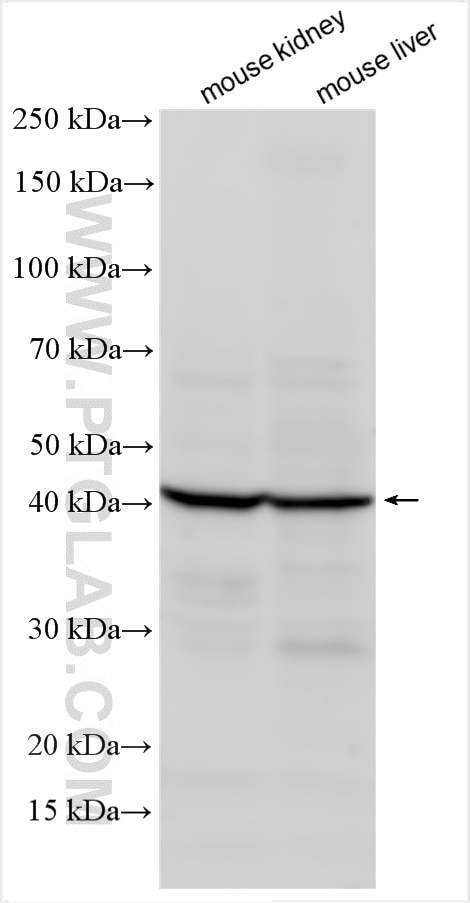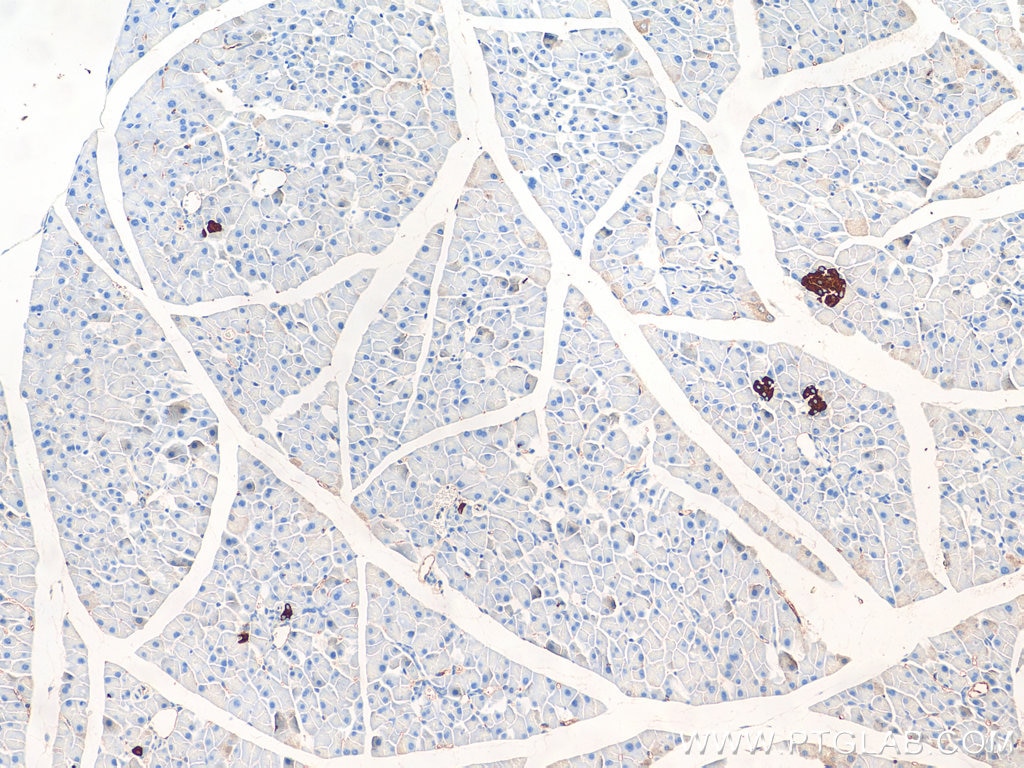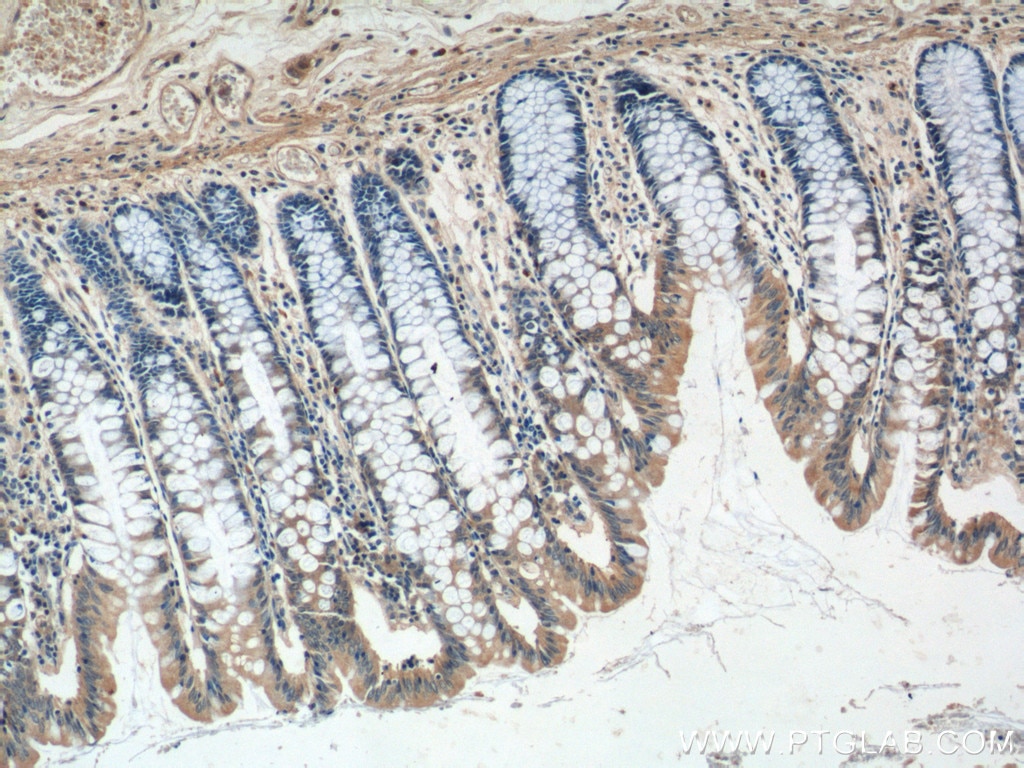- Featured Product
- KD/KO Validated
GPR81 Polyklonaler Antikörper
GPR81 Polyklonal Antikörper für WB, IHC, ELISA
Wirt / Isotyp
Kaninchen / IgG
Getestete Reaktivität
human, Maus und mehr (1)
Anwendung
WB, IHC, IF, ELISA
Konjugation
Unkonjugiert
Kat-Nr. : 20146-1-AP
Synonyme
Geprüfte Anwendungen
| Erfolgreiche Detektion in WB | Mausnierengewebe, Mauslebergewebe |
| Erfolgreiche Detektion in IHC | Maus-Pankreasgewebe, humanes Kolongewebe, humanes Pankreasgewebe Hinweis: Antigendemaskierung mit TE-Puffer pH 9,0 empfohlen. (*) Wahlweise kann die Antigendemaskierung auch mit Citratpuffer pH 6,0 erfolgen. |
Empfohlene Verdünnung
| Anwendung | Verdünnung |
|---|---|
| Western Blot (WB) | WB : 1:500-1:1000 |
| Immunhistochemie (IHC) | IHC : 1:250-1:1000 |
| It is recommended that this reagent should be titrated in each testing system to obtain optimal results. | |
| Sample-dependent, check data in validation data gallery | |
Veröffentlichte Anwendungen
| KD/KO | See 1 publications below |
| WB | See 3 publications below |
| IHC | See 1 publications below |
| IF | See 1 publications below |
Produktinformation
20146-1-AP bindet in WB, IHC, IF, ELISA GPR81 und zeigt Reaktivität mit human, Maus
| Getestete Reaktivität | human, Maus |
| In Publikationen genannte Reaktivität | human, Maus, Ratte |
| Wirt / Isotyp | Kaninchen / IgG |
| Klonalität | Polyklonal |
| Typ | Antikörper |
| Immunogen | GPR81 fusion protein Ag13682 |
| Vollständiger Name | G protein-coupled receptor 81 |
| Berechnetes Molekulargewicht | 346 aa, 39 kDa |
| Beobachtetes Molekulargewicht | 39 kDa |
| GenBank-Zugangsnummer | BC066881 |
| Gene symbol | GPR81 |
| Gene ID (NCBI) | 27198 |
| Konjugation | Unkonjugiert |
| Form | Liquid |
| Reinigungsmethode | Antigen-Affinitätsreinigung |
| Lagerungspuffer | PBS with 0.02% sodium azide and 50% glycerol |
| Lagerungsbedingungen | Bei -20°C lagern. Nach dem Versand ein Jahr lang stabil Aliquotieren ist bei -20oC Lagerung nicht notwendig. 20ul Größen enthalten 0,1% BSA. |
Hintergrundinformationen
GPR81 (G protein-coupled receptor 81) is one of a large family of GPRs with low affinity for hydroxy-carboxylic acid structure ligands (PMID: 24657625). Lactate functions as a signaling molecule by serving as an agonist for the GPR81, involving both autocrine and paracrine mechanisms (PMID: 31836453). Moreover, A higher molecular mass band (∼60 kDa) is present in the brain and adipose tissue. This band is also strong in the transfected HeLa cells but weak in native HeLa cells and is therefore probably a form of GPR81, possibly a glycosylated form of the receptor (PMID: 23696276).
Protokolle
| PRODUKTSPEZIFISCHE PROTOKOLLE | |
|---|---|
| WB protocol for GPR81 antibody 20146-1-AP | Protokoll herunterladen |
| IHC protocol for GPR81 antibody 20146-1-AP | Protokoll herunterladenl |
| STANDARD-PROTOKOLLE | |
|---|---|
| Klicken Sie hier, um unsere Standardprotokolle anzuzeigen |
Publikationen
| Species | Application | Title |
|---|---|---|
Life Sci Aerobic exercise regulates GPR81 signal pathway and mediates complement- microglia axis homeostasis on synaptic protection in the early stage of Alzheimer's disease | ||
Front Oncol Lactate increases tumor malignancy by promoting tumor small extracellular vesicles production via the GPR81-cAMP-PKA-HIF-1α axis
| ||
Sci Rep PET-CT and RNA sequencing reveal novel targets for acupuncture-induced lowering of blood pressure in spontaneously hypertensive rats. | ||
Placenta Immunohistochemical localization of HCA1 receptor in placenta in presence of fetal growth restriction | ||
Adv Sci (Weinh) Breed-Driven Microbiome Heterogeneity Regulates Intestinal Stem Cell Proliferation via Lactobacillus-Lactate-GPR81 Signaling |








